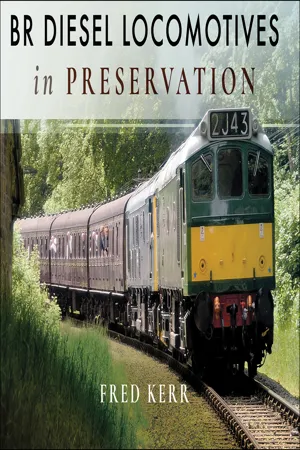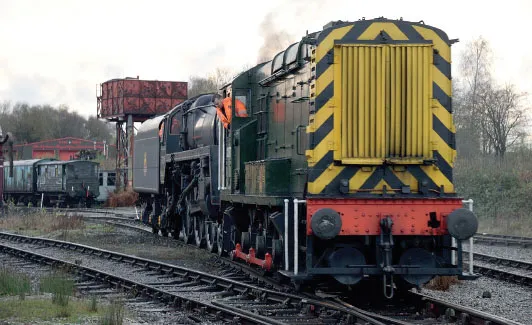![]()
Section 1:
Shunting Locomotives
1.1: Pre-Nationalization Designs
Whilst many steam locomotive manufacturers had begun the development of small diesel shunting locomotives after their success in the First World War, the main line railway companies remained committed to steam locomotives with most locomotives being built within their own workshops. One major exception was the London Midland Scottish Railway Company (LMSR) which by the late 1920s had identified steam locomotive shunters as an expense which needed to be reduced and began trialling locomotives from outside builders during the 1930s as it sought to identify standard designs for its future needs.
Turning to established builders the LMSR bought small shunters (100–250 hp) from the Hunslet Engine Company Ltd and large shunters (300–400 hp) from both Armstrong Whitworth and English Electric for comparison.
1.1.1: Hunslet Engine Co Ltd
Builder
Hunslet Engine Co
Year Built
1933
Engine
MAN 6-Cylinder 150 hp @ 900 rpm
Transmission
Mechanical
LMSR Fleet Numbers
7401–7404 (later 7051–7054)
Ordered as one of four locomotives with different combinations of engine and transmission, 7401 was operated from Leeds Hunslet Road adjacent to its builder’s workshops. It was renumbered 7051 by the LMSR in 1934 and by 1936 was based at Chester. At the onset of the Second World War the four locomotives were borrowed by the War Department (WD) with 7051 being returned to, and borrowed from, the LMSR during 1940–45. On return to the LMSR in 1945, 7051 was sold to Hunslet in December 1945. The locomotive was fitted with a McLaren Ricardo MR6 diesel engine rated at 132 hp and used for short-term hire until being sold to the Middleton Railway Trust in 1960, where it was named John Alcock.
7051 is in LMS guise as it works a shuttle service on the demonstration line at Barrow Hill (BHR) during a diesel gala on 5 October 2003.
1.1.2: London Midland Scottish Railway Company
Builder
LMSR/BR Derby; BR Darlington
Year Built
1945–1952
Engine
English Electric 6-cylinder 6KT rated at 350 hp @ 680 rpm
Transmission
Electric
Fleet Numbers
LMSR = 7100–7109; 7120–7155; BR = 12033–12138
AD601 was the 13th locomotive built as part of the order for twenty supplied to the Ministry of Supply in 1945 and was delivered to Longmoor Military Railway (LMR). It was subsequently renumbered to 878 in 1952 and finally to AD601 in 1980 prior to being sold to the Lakeside & Haverthwaite Railway (LHR) in December 1980. On the LHR it sometimes (confusingly) carries LMSR guise as 7120 although the original LMSR 7120 was renumbered to 12033 by BR and withdrawn from service in January 1969.
History: The LMSR was interested in a large shunter for use in busy yards and light inter-yard trip working and trialled two designs in 1935 – placing orders with Armstrong Whitworth (AW) (LMSR Nos. 7059–7068) using a Sulzer engine and jackshaft electrical transmission and Hawthorn Leslie (HL) (LMSR Nos. 7069–7078) using an English Electric engine and electric transmission linked directly to a traction motor on each outer axle.
The result of the trials was to identify the AW locomotives layout as superior but the company had ceased locomotive production in 1937 to concentrate on armaments production, hence the LMSR elected to build further locomotives at its Derby works.
It initially built thirty locomotives (LMSR Nos. 7080–7099 and 7110–7119) to the AW layout, albeit with English Electric 6KT engines, but subsequently adopted the HL drive train (LMSR Nos. 7100–7109) for the War Department in 1940 and this became the standard configuration for future designs.
Further orders to the ‘standard’ design appeared in the 1940s with orders for LMSR 7120–32 (later BR 12033–45) and Ministry of Supply 70260–70273; after the Second World War the LMSR continued building the class and this continued after the 1948 nationalization with Derby finalising building at 12102 whilst a batch of locomotives (12103–12138) was delivered from Darlington Works for the Eastern Region (ER) of BR between March 1952 and January 1953.
AD601 approaches Newby Bridge (LHR) on 6 March 2015 whilst working the Lakeside–Haverthwaite leg of a railway tour chartered by the Preserved Locomotives Enthusiasts Group (PLEG).
12077 acts as shed pilot on 8 November 2014 whilst shunting Standard Class 5 4-6-0 73129 into the shed building at Swanwick Junction (MRC).
12077 entered service at Saltley depot in October 1950 and was withdrawn from Wigan Springs Branch depot in October 1971. It was sold into industrial service in 1972 from where it entered preservation with the Midland Railway Centre (MRC) at Butterley in February 1979.
12099 entered service at Nottingham depot in February 1952 and was withdrawn from Bletchley depot in July 1971. It was sold into industrial service in March 1972 from where it entered preservation with the Severn Valley Railway (SVR) in March 1990.
12099 is paired with Class 08 D3201 as they approach Kidderminster (SVR) on 2 October 2015 whilst hauling the 10:10 Bewdley–Kidderminster service during the annual diesel gala event.
1.2: Post-Nationalization Designs
When the UK railway companies were formed into British Railways (BR) from 1 January 1948, the LMSR became the London Midland Region (LMR) and continued building its 0-6-0 diesel design. That design however was found to be too heavy for smaller yards such as industrial sidings and docksides hence the nascent BR turned to industry for smaller 0-4-0 and 0-6-0 designs with power ranges from 150 hp to 250 hp.
This demand was met by such builders as Andrew Barclay (D2400–2409; D2410–2444; D2953–2956); Drewry Car (D2200–2214; D2215–2273; D2274–2341); Hudswell Clarke (D2500–2519; D2550–2618); Hunslet Engine Co (D2950–2952); North British Locomotive Co (D2700–2707; D2708–2780; D2900–2913); Ruston & Hornsby (PWM651–654; D2957–2958; D2985–2998) and Yorkshire Engine Co (D2850–2869) whilst BR’s workshops at Swindon and Doncaster s...




